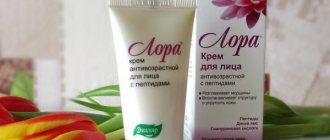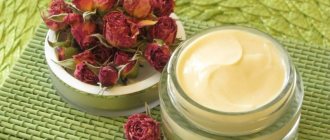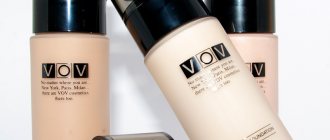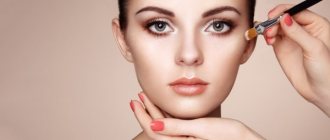Caring for problem skin is always particularly difficult. It is difficult to get rid of numerous rashes, post-acne, greasy shine, and enlarged pores. To effectively mask problems, you will also have to make a lot of effort. A good option, recommended by many cosmetologists, is to perform a course of peelings. After the procedures, be sure to properly care for the skin to help the recovery process. Doctors often prescribe Christina post-peel foundation to mask problem areas, dry, heal rashes, and protect the skin. Let's consider the strengths and weaknesses of a professional special-purpose tool.
general description
Christina's foundation for post-peeling skin care is the fifth step in the intensive cleansing program of the Rose de Mer line. The substance has a dense texture, tonal effect, antioxidant, soothing effect, and contains UV filters. The product is packaged in classic 20 ml jars.
The basic components that ensure the effective operation of the substance are:
- zinc oxide (UV filter, has an astringent, antiseptic effect, normalizes sebum secretion);
- talc (mattifies, softens the surface, provides a velvety effect, maintains the absorbent properties of the substance, helps visually mask imperfections when focusing attention);
- red clay (masks defects, dries out imperfections);
- alaria extract (powerful antioxidant effect);
- jojoba oil (regeneration, sun protection, natural light tonal effect);
- shea butter (regeneration, moisturizing, antioxidant, UV protection, natural support for tonal effect);
- rosehip oil (moisturizing, anti-inflammatory, decongestant effect);
- tocopheryl acetate (nutrition, softening, antioxidant protection);
- bisabolol (soothing properties);
- retinyl palmitate (softening the stratum corneum, lightening age spots, post-acne, stimulating tissue renewal);
- caprylic triglyceride (barrier to moisture loss).
The cream also includes plant extracts, elastin, collagen isolated from marine life, deionized water, carnauba wax, titanium dioxide, benzophenone, octyl methoxycinamate, and other components to maintain the functional qualities of the substance.
What types of peelings are there?
Dead cells are removed by acting on one of three skin levels - this is how peelings differ in depth of penetration.
Superficial, low-traumatic peeling whitens age spots and refreshes the skin without affecting the sensitive layer. Sometimes this type of peeling is used to prepare for cleansing the middle layers of the skin.
The rejuvenating process of medium peeling encourages cell renewal, causes collagen formation and helps lymph flow. Medium peeling is used by girls from 25-27 years old, for which they prepare the skin for the procedure for 2 weeks.
The aggressive deep peeling procedure is compared to plastic surgery, which smoothes out fine and deep wrinkles, eliminates acne marks, scars and evens out the surface of the skin.
Deep peeling, which requires anesthesia, is done using hardware or chemical methods only in a cosmetology clinic.
Indications, effectiveness of use
As the name suggests, post peeling cover cream from Christina is intended for use after peeling. The product provides:
- camouflage problem areas (acne, scars, dark spots from acne, hyperpigmentation, wrinkles, post-peeling peeling);
- UV protection;
- calming, nutrition, tissue hydration;
- additional antiseptic, regenerating effect;
- antioxidant protection.
Important! This option is best suited for oily skin with obvious problems (rashes). The cream is also effective for combination, normal and sensitive skin. When used on dry, flabby surfaces, the condition of the tissues may worsen due to the dense texture and drying effect of the product.
As a result of using post-peeling protective foundation from Christina, you can lead a normal lifestyle during exfoliation procedures and during rehabilitation after interventions. The face looks as aesthetically pleasing as possible, is protected from adverse effects, and additional skin care is provided.
What happens to the face after peeling
The trauma to the skin after peeling is quite deep and serious, so the skin experiences severe stress for some time. Regardless of the method of exposure - laser, chemical or ultrasound, a powerful regeneration process is launched at the cellular level, which is aimed at smoothing out the consequences of the injury. Visually, this manifests itself in the healing of scars and cicatrices, lightening or complete disappearance of spots. Due to the fact that many new young cells were formed during this period, and the old layer was removed through exfoliation, the skin becomes elastic and velvety.
In the first days after peeling, the skin is very vulnerable to external irritants, so even washing should be as delicate and gentle as possible. You should not use tap water, as there is a high risk of infection with further complications.
The natural reaction of the skin to peeling is skin tightness and the formation of a dry film, which gradually cracks and disappears from the face. Usually this stage occurs on the third day after the procedure. It does not look aesthetically pleasing, but from the point of view of skin renewal, it is a necessary process. The detachment of old skin cells indicates that an active renewal process is underway. Scars may also form on the skin - this is a normal reaction to the injury.
ATTENTION! It is strictly forbidden to remove exfoliated skin and crusts yourself with your hands or homemade cosmetics (scrubs). This can lead to scarring and other complications!
We invite you to see how to apply makeup to your face after peeling:
Rules of application
Post-peeling foundation from Christina is recommended for use after deep peelings and other active cosmetic procedures with a noticeable rehabilitation stage. The substance can be used daily on a regular basis to camouflage and protect the skin of those who are dissatisfied with the condition of the skin (excessive rashes).
It is better to coordinate the scheme of use of the foundation product with the treating cosmetologist. Typically, this option is prescribed for use during the rehabilitation period after aggressive procedures. Start using the product immediately after performing Rose de Mer peeling (when carrying out procedures with other substances, the timing will be determined by the cosmetologist).
The cream can be used for any skin type. Regular use is suitable for oily skin; for dry, flabby, sensitive skin - only as post-peeling care prescribed by a doctor.
The product is distributed in any convenient way: with fingers, sponge, brush. Before application, it is recommended to place a sufficient amount of the substance in the palm of your hand. The thick cream softens under the influence of heat, making the product easier to apply evenly.
To obtain a thin layer of foundation, it is better to use your fingers. Using your hands will help you distribute the substance more evenly and achieve a natural effect. A brush or sponge is used to create a dense base. The smears are placed carefully. It is important not to injure delicate tissues.
The tonal cover product Christina is available in a single color. In the jar the product looks dark and often “scares” consumers. During application, the substance has a reddish tan tint, but quickly turns red and adapts to the natural skin tone.
For a very pale natural color of the integument, the option may be truly dark.
Christina foundation cover cream is applied only to previously prepared skin. Before using the substance, you need to wash your face, treat your skin with toner, and apply a light moisturizer.
To remove foundation, regular washing with a light cleanser (gel, foam) is not enough. Makeup removal is carried out using a specialized composition with a delicate effect. The use of aggressive substances and excessive skin friction are excluded.
What not to do after peeling
Immediately after a chemical peel, you should not do anything that causes irritation or infection of the skin:
- Running water contains many impurities and bacteria, so for the first 3 days you need to wash your face with warm boiled or bottled water. In the following days, you can use delicate cleansers with a soft texture (without abrasives).
- Many girls are interested in whether it is possible to use cosmetics after peeling, as they want to disguise peeling and blemishes. It is prohibited to use any decorative cosmetics for 15 days. It clogs pores and promotes the growth of bacteria. In addition, visual foundations further emphasize imperfections on the face.
- If you experience any discomfort after peeling your face, you should stop self-medicating and using proven cosmetics. First of all, you need to consult a cosmetologist.
- Any actions and procedures that cause active sweating and a rush of blood should be postponed for a while. This includes sports, baths, physical work, etc.
- To avoid negative reactions, you need to minimize contact with facial skin. Do not touch your face with your hands or apply unfamiliar cosmetics to it.
Precautionary measures
There are practically no contraindications to the use of post-peeling foundation from Christina. Avoid the substance if you are allergic to the components of the product. Do not use the product for open skin lesions (scratches, wounds, as well as burns, irritation).
You can mask the inflammation present on the skin without hesitation. When using the cream as post-peeling (part of rehabilitation) care, they are guided by contraindications to the basic procedure (exfoliation, other effects), and take into account the recommendations of the cosmetologist who performed the intervention.
There are no side effects when used correctly. The main requirement is to exclude allergies to components. To do this, it is recommended to analyze the existing individual reactions of the body and conduct preliminary testing of the product (application to a hidden area of the body to control possible negative manifestations).
Attention! If the cream is used incorrectly, excessive drying of the skin and clogging of pores may occur. This can be prevented by applying a protective product to skin previously moistened with a special product, avoiding regular use of Christina post-peeling foundation for dry skin types, and thoroughly cleansing tissues of makeup.
How peeling affects the skin
Exfoliation is the application of a special composition to the skin that exfoliates dead skin particles. The procedure is suitable for those who want to even out the relief of the epidermis, reduce sebum production, remove fine wrinkles, and restore tissue elasticity. Chemical peeling renews cells, but at the same time injures the skin . As a result, girls and women face the following consequences:
- peeling,
- edema,
- burning,
- tingling,
- redness.
Redness on the skin after peeling
The listed symptoms may last from two to five days. Cosmetologists claim that such a reaction is considered normal, since the skin gets rid of “dead” cells, and therefore experiences stress.
Please note that after exfoliation there should be no inflammation, ulcers or severe itching. If you have such symptoms, you should definitely consult a doctor.
Advantages and disadvantages
The advantages of Christina foundation for post-peeling care are the versatility of the product: the substance is used by owners of any skin type to mask problems, protect against adverse factors, and provide additional skin care.
This option can be used situationally or on a regular basis.
The disadvantages of the product are the need to comply with the principles of using the substance. If used incorrectly, complications may occur. Obtaining a beneficial effect depends on the nuances of using the product. The option has a high price. Many consumers consider it inappropriate to purchase such a cream for short-term use.
There are two main types of makeup
- Everyday, where the desire to decorate yourself and highlight the advantageous aspects of your appearance completely coincides with the modern capabilities of decorative cosmetics manufacturers and training seminars where you will be taught how to do makeup without makeup and draw eyebrows beautifully;
- Dermatological camouflage. As noted by Professor E.R. Arabian (Clinical Dermatology and Venereology. 2007), the so-called camouflage cosmetics, or corrective cosmetics, are widely used at present. The purpose of its use is to disguise pronounced defects in open areas of the skin: face, neck, hands. Thus, camouflage cosmetics are indicated for patients with congenital and acquired pigmentation disorders (vitiligo, albinism, melasma, post-inflammatory hyper- and hypopigmentation, nevi, etc.), acne, scars and cicatricial atrophy, vascular skin diseases (hemangiomas, rosacea) and other conditions . In cosmetology, such products are prescribed for persistent facial erythema and other complications after medium and deep chemical peels, laser resurfacing and dermabrasion. Also important is the ability to disguise tattoos and permanent makeup that is inadequate from an aesthetic point of view. An example of camouflage cosmetics is the ultra-resistant corrective system Dermablend (VICHY Laboratories, France), which includes an intensive camouflaging corrective base and fixing powder to complete the makeup.
Opinion of cosmetologists
Doctors use Christina cosmetics in their work. The foundation for post-peeling care is part of the Rose de Mer series, complementing the popular coral exfoliant. This option is used when performing the procedure and is recommended for home use.
The cosmetologist recognizes the beneficial effects of post-peeling care from Christina.
The cosmetologist recommends post-peeling care Christina.
The cosmetologist recommends an option, but pays attention to the nuances of the substance.
What components should be contained in post-peeling products and why?
When choosing post-peeling moisturizers, it is recommended to purchase creams and ointments with substances that help the skin barrier to recover more quickly. In addition, with components that accelerate skin healing and enhance the rebirth of new cells.
And also - with antioxidants.
The basis for cream and ointment should be thermal water.
Cosmetologists advise using the following products:
with hyaluronic and fruit acids;- with amino acids and antioxidants;
- with collagen and alginates;
- with vitamins A, B, C, E, urea and lanolin;
- with natural plant extracts and oils;
- with aloe and algae extracts.
Natural components of medicinal creams and ointments relieve discomfort, moisturize and eliminate tightness. More often, such products are prescribed by a cosmetologist.
Important! You cannot use creams with silicones, parabens and artificial dyes, with fragrances and sodium sulfate laureate, with mineral oil.
Patient reviews
Christina's post-peeling foundation is used for care after exfoliation procedures and in everyday life. They like the option, consumers see a positive result. Christina's protective cream is convenient and versatile, which is also important.
Positive opinion about Christina foundation for post-peeling care during use after the procedure and on a regular basis.
The consumer finds the universal version of the substance convenient.
The consumer has been using the cream for a long time and likes the result, but there are some nuances.










